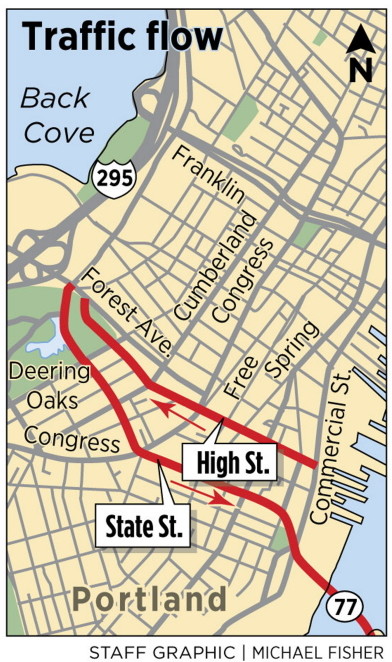The conversion of two downtown Portland commuter arteries from one-way to two-way streets would improve safety for pedestrians, bicyclists and motorists. But it also would slightly increase travel time across the downtown peninsula and could increase the risk of low-speed traffic accidents at realigned intersections.
Those are among the findings of an analysis presented Wednesday night to a city advisory panel studying the future of State and High streets.
Members of the State and High Streets Project Advisory Committee took a straw poll at the meeting, revealing that 18 out of 20 members support moving ahead with the study.
Ian Jacob, a representative for the West End Neighborhood Association who serves on the advisory panel, said his group supports converting both streets to two-way. “These streets now are almost like highways. I’d say do it now because the positives (in the analysis) outweigh the negatives,” Jacob said.
Members who support the conversion say they have concerns about providing adequate on-street parking and safety for bicyclists, but do not see those as insurmountable issues.
Carol Morris, a consultant who is handling public outreach for the committee, said Tom Errico, the traffic engineer whose firm is conducting the analysis, will do more work before the final report is presented to a public hearing sometime in late February. After the hearing, the panel will reconvene in March to make a final decision on whether to recommend implementing the plan.
“The purpose of this study is to see if this would be feasible, and what Tom has found out is that it could be,” Morris told the panel.
There would be a cost associated with converting High and State streets to two-way roads, but Errico’s study has yet to reach any conclusions about cost.
“There is a cost implication. It’s not going to be cheap, but I’m told it’s not going to be millions,” Errico said.
The advisory committee was formed in July and began exploring the potential benefits and drawbacks of converting State and High streets to two-way traffic in response to concerns about pedestrian safety on the two busy arterials that carry commuter traffic across the downtown peninsula.
Members of the panel are examining factors such as mobility, parking and safety, as well as estimating the cost of making any proposed changes and completing needed upgrades to the streets.
City officials released an initial analysis of the pros and cons of converting the streets. It found:
— Changing to two-way traffic would decrease traffic speeds and increase travel times across the peninsula. It also would add congestion at intersections, which could increase air pollution.
— Lower speeds would improve traffic safety, but could lead to more minor accidents because of changes in traffic flow at intersections. Although slower speeds would increase pedestrian safety, new turning patterns could create additional vehicle-pedestrian conflicts.
— Parking along State and High streets would likely be reduced by 9 percent, but some additional parking would be made available near Deering Oaks park.
— The city would have to spend an unknown amount on new traffic signals and intersection improvements to allow all vehicles, including large delivery trucks, to make necessary turns.
— Changes could affect Longfellow Square, which has a historic designation. It was expanded in 2005 to increase the amount of pedestrian space, but could shrink if the road is converted. It’s unclear if changes would force the city to relocate the statue of Henry Wadsworth Longfellow.
Morris said that if the conversion moves forward, intersections would be redesigned to minimize the impact on Longfellow Square and reduce the amount of private land that may need to be taken.
Regarding Longfellow Square, the Historic Preservation Board also would have a role to play, she said.
The statue of Longfellow, a Portland native and famous 19th century poet, was made by Franklin Simmons, a Portland resident who moved to Rome, Italy. The $17,000 statue was financed by Maine Central Railroad’s Payson Tucker and was dedicated on Sept. 29, 1888. It was added to the National Register of Historic Places in 1990.
Along with the analysis of pros and cons, the advisory committee was presented with a list of communities that have recently converted one-way streets to two-way traffic.
In most cases, businesses benefited from the conversion and property values increased. Louisville, Kentucky, reported a 39 percent increase in property values after a 2011 conversion. It also reported a 23 percent reduction in overall crime along the newly converted streets.
However, commuters in Lowell, Massachusetts, expressed negative opinions about the conversions of six streets in September 2014. One street was returned to its original one-way traffic flow because large vehicles had trouble turning on the 11-foot-wide road.
Staff Writer Dennis Hoey contributed to this report.
Randy Billings can be contacted at 791-6346 or at:
rbillings@pressherald.com
Twitter: @randybillings
Copy the Story LinkSend questions/comments to the editors.




Success. Please wait for the page to reload. If the page does not reload within 5 seconds, please refresh the page.
Enter your email and password to access comments.
Hi, to comment on stories you must . This profile is in addition to your subscription and website login.
Already have a commenting profile? .
Invalid username/password.
Please check your email to confirm and complete your registration.
Only subscribers are eligible to post comments. Please subscribe or login first for digital access. Here’s why.
Use the form below to reset your password. When you've submitted your account email, we will send an email with a reset code.